英语的修辞手法英语的45种修辞手法定义解释.doc
英语中的十九种修辞
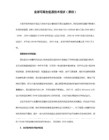
1>.The birds sat upon a tree and poured forth their lily like voice。(用视觉形容听觉,鸟落在树上,由它发出的声音联想到百合花)
鸟儿落在树上,倾泻出百合花似的声音。
2>.Taste the music of Mozart。(用嗅觉形容听觉)
这也是一种矛盾修辞法,用两种不相调和的特征形容一个事物,以不协调的搭配使读者领悟句中微妙的含义。
例如:
1>.No light, but rather darkness visible。没有光亮,黑暗却清晰可见
2>.The state of this house is cheerless welcome。
例如:
1>.How was it possible to walk for an hour through the woods and see nothing worth of note?
2>.Shall we allow பைடு நூலகம்hose untruths to go unanswered?
15.Antithesis 对照,对比,对偶
例如:
1>.Hope is a good breakfast, but it is a bad supper。
2>.Some books are to be tasted, others swallowed, and some few to be chewed and digested。
3.Metonymy 借喻,转喻
2>.I wandered lonely as a cloud。
英语中的修辞手法及英英释义
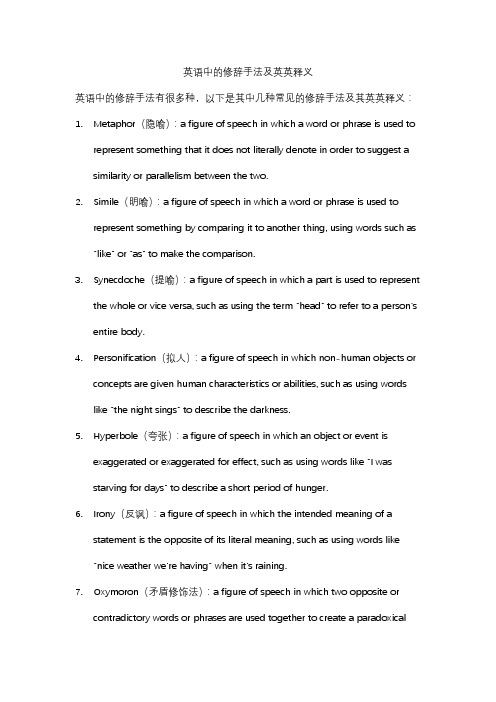
英语中的修辞手法及英英释义英语中的修辞手法有很多种,以下是其中几种常见的修辞手法及其英英释义:1.Metaphor(隐喻):a figure of speech in which a word or phrase is used torepresent something that it does not literally denote in order to suggest a similarity or parallelism between the two.2.Simile(明喻):a figure of speech in which a word or phrase is used torepresent something by comparing it to another thing, using words such as "like" or "as" to make the comparison.3.Synecdoche(提喻):a figure of speech in which a part is used to representthe whole or vice versa, such as using the term "head" to refer to a person's entire body.4.Personification(拟人):a figure of speech in which non-human objects orconcepts are given human characteristics or abilities, such as using words like "the night sings" to describe the darkness.5.Hyperbole(夸张):a figure of speech in which an object or event isexaggerated or exaggerated for effect, such as using words like "I wasstarving for days" to describe a short period of hunger.6.Irony(反讽):a figure of speech in which the intended meaning of astatement is the opposite of its literal meaning, such as using words like"nice weather we're having" when it's raining.7.Oxymoron(矛盾修饰法):a figure of speech in which two opposite orcontradictory words or phrases are used together to create a paradoxicaleffect, such as using words like "bittersweet" to describe a mixed feeling of happiness and sadness.这些修辞手法都可以增强语言的表达力,帮助传达更深刻的意义。
英语中19种修辞手法的全部解释和例句解析

8.Parallelism 排比, 平行
这种修辞法是把两个或两个以上的结构大 体相同或相似,意思相关,语气一致的短语. 句子排列成串,形成一个整体. 1>.No one can be perfectly free till all are free; no one can be perfectly moral till all are moral; no one can be perfectly happy till all are happy. 所有的人自由後,才能完全自由;所有的 人都有道德,才能完全合乎道德;所有的 人都幸福了,才能真正幸福。
2.Metaphor 隐喻,暗喻
隐喻是简缩了的明喻,是将某一事物 的名称用于另一事物,通过比较形成. 例如: 1>.Hope is a good breakfast, but it is a bad supper. 2>.Some books are to be tasted, others swallowed, and some few to be chewed and digested.
这种修辞是将一系列词语按照意念的大 小.轻重.深浅.高低等逐层渐进,最后达到 顶点.可以增强语势,逐渐加深读者印象. 例如: 1>.I am sorry, I am so sorry, I am so extremely sorry.
19.Anticlimax 渐降法
The duties of a soldier are to protect his country and peel potatoes.
11.Iro误时,用赞同过 失的说法,而在表扬时,则近乎责难的说 法. 1>.It would be a fine thing indeed not knowing what time it was in the morning. 早上没有时间观念还真是一件 好事啊(真实含义是应该明确早上的时 间观念)
英语中有19种修辞手法

英语中有19种修辞手法,它们分别是:Simile明喻、Metaphor 隐喻,暗喻、Metonymy 借喻,转喻、Synecdoche 提喻、Synaesthesia 通感,联觉,移觉、Personification 拟人、Hyperbole 夸张、Parallelism 排比,平行、Euphemism 委婉,婉辞法、Allegory 讽喻,比方、Irony 反语、Pun 双关、Parody 仿拟、Rhetorical question 修辞疑问、Antithesis 对照,对比,对偶、Paradox 隽语、Oxymoron 反意法,逆喻、Climax 渐进法,层进法、Anticlimax 渐降法。
下面和大家分享一下这19种修辞手法的全部解释和例句,快来学习吧!1.Simile 明喻明喻是将具有共性的不同事物作对比。
这种共性存有于人们的心里,而不是事物的自然属性。
标志词常用like, as, seem, as if, as though, similar to, such as等。
例如:1>.He was like a cock who thought the sun had risen to hear him crow。
2>.I wandered lonely as a cloud。
3>.Einstein only had a blanket on, as if he had just walked out of a fairy tale。
2.Metaphor 隐喻,暗喻隐喻是简缩了的明喻,是将某一事物的名称用于另一事物,通过比较形成。
例如:1>.Hope is a good breakfast, but it is a bad supper。
2>.Some books are to be tasted, others swallowed, and some few to be chewed and digested。
(完整word版)高级英语各单元修辞
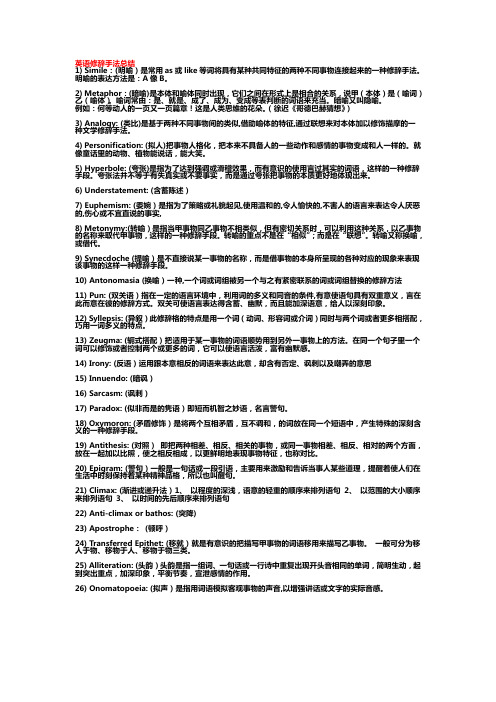
英语修辞手法总结1) Simile:(明喻)是常用as或like等词将具有某种共同特征的两种不同事物连接起来的一种修辞手法。
明喻的表达方法是:A像B。
2) Metaphor:(暗喻)是本体和喻体同时出现,它们之间在形式上是相合的关系,说甲(本体)是(喻词)乙(喻体)。
喻词常由:是、就是、成了、成为、变成等表判断的词语来充当。
暗喻又叫隐喻。
例如:何等动人的一页又一页篇章!这是人类思维的花朵。
(徐迟《哥德巴赫猜想》)3) Analogy: (类比)是基于两种不同事物间的类似,借助喻体的特征,通过联想来对本体加以修饰描摩的一种文学修辞手法。
4) Personification: (拟人)把事物人格化,把本来不具备人的一些动作和感情的事物变成和人一样的。
就像童话里的动物、植物能说话,能大笑。
5) Hyperbole: (夸张)是指为了达到强调或滑稽效果,而有意识的使用言过其实的词语,这样的一种修辞手段。
夸张法并不等于有失真实或不要事实,而是通过夸张把事物的本质更好地体现出来。
6) Understatement: (含蓄陈述)7) Euphemism: (委婉)是指为了策略或礼貌起见,使用温和的,令人愉快的,不害人的语言来表达令人厌恶的,伤心或不宜直说的事实,8) Metonymy:(转喻)是指当甲事物同乙事物不相类似,但有密切关系时,可以利用这种关系,以乙事物的名称来取代甲事物,这样的一种修辞手段。
转喻的重点不是在“相似”;而是在“联想”。
转喻又称换喻,或借代。
9) Synecdoche (提喻)是不直接说某一事物的名称,而是借事物的本身所呈现的各种对应的现象来表现该事物的这样一种修辞手段。
10) Antonomasia (换喻)一种,一个词或词组被另一个与之有紧密联系的词或词组替换的修辞方法11) Pun: (双关语)指在一定的语言环境中,利用词的多义和同音的条件,有意使语句具有双重意义,言在此而意在彼的修辞方式。
(完整版)英语中的修辞手法
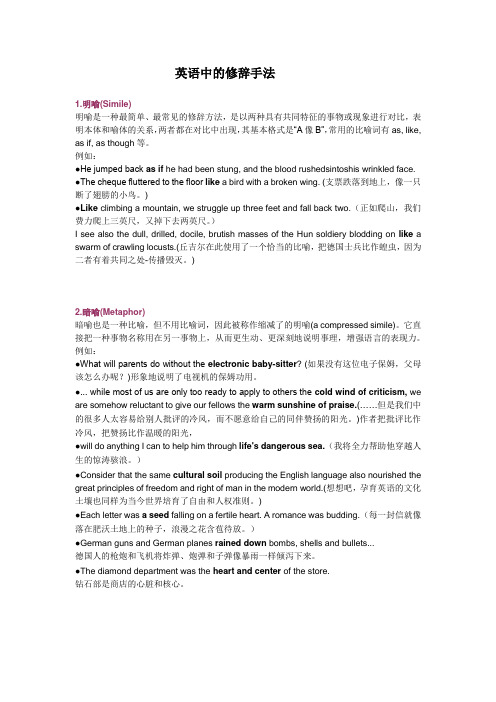
英语中的修辞手法1.明喻(Simile)明喻是一种最简单、最常见的修辞方法,是以两种具有共同特征的事物或现象进行对比,表明本体和喻体的关系,两者都在对比中出现,其基本格式是“A像B”,常用的比喻词有as, like, as if, as though等。
例如:●He jumped back as if he had been stung, and the blood rushedsintoshis wrinkled face.●The cheque fluttered to the floor like a bird with a broken wing. (支票跌落到地上,像一只断了翅膀的小鸟。
)●Like climbing a mountain, we struggle up three feet and fall back two.(正如爬山,我们费力爬上三英尺,又掉下去两英尺。
)I see also the dull, drilled, docile, brutish masses of the Hun soldiery blodding on like a swarm of crawling locusts.(丘吉尔在此使用了一个恰当的比喻,把德国士兵比作蝗虫,因为二者有着共同之处-传播毁灭。
)2.暗喻(Metaphor)暗喻也是一种比喻,但不用比喻词,因此被称作缩减了的明喻(a compressed simile)。
它直接把一种事物名称用在另一事物上,从而更生动、更深刻地说明事理,增强语言的表现力。
例如:●What will parents do without the electronic baby-sitter? (如果没有这位电子保姆,父母该怎么办呢?)形象地说明了电视机的保姆功用。
●... while most of us are only too ready to apply to others the cold wind of criticism, we are somehow reluctant to give our fellows the warm sunshine of praise.(……但是我们中的很多人太容易给别人批评的冷风,而不愿意给自己的同伴赞扬的阳光。
(完整word版)英语的修辞手法英语的45种修辞手法定义解释
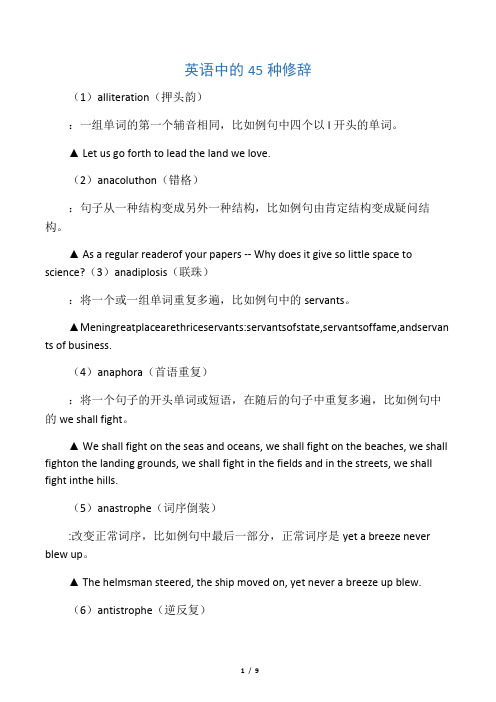
英语中的45种修辞(1)alliteration(押头韵):一组单词的第一个辅音相同,比如例句中四个以l开头的单词。
▲ Let us go forth to lead the land we love.(2)anacoluthon(错格):句子从一种结构变成另外一种结构,比如例句由肯定结构变成疑问结构。
▲ As a regular readerof your papers -- Why does it give so little space to science?(3)anadiplosis(联珠):将一个或一组单词重复多遍,比如例句中的servants。
▲Meningreatplacearethriceservants:servantsofstate,servantsoffame,andservan ts of business.(4)anaphora(首语重复):将一个句子的开头单词或短语,在随后的句子中重复多遍,比如例句中的we shall fight。
▲ We shall fight on the seas and oceans, we shall fight on the beaches, we shall fighton the landing grounds, we shall fight in the fields and in the streets, we shall fight inthe hills.(5)anastrophe(词序倒装):改变正常词序,比如例句中最后一部分,正常词序是yet a breeze never blew up。
▲ The helmsman steered, the ship moved on, yet never a breeze up blew.(6)antistrophe(逆反复):在每个句子的结尾,重复相同的单词或短语,比如例句中的without warning。
英语修辞手法45种

45种英语修辞(1)alliteration(押头韵):一组单词的第一个辅音相同.When the things happen that you do not like, you have two choices: You get bitter or better(2)metaphor(隐喻):利用某些单词进行含蓄的比喻,此时这些单词已经不再是字面上的意思了,Strawberries flooded the market and prices dropped down. (草莓充斥市场,价格下跌)。
(3)anadiplosis(联珠):将一个或一组单词重复多遍,Men in great place are thrice servants: servants of state, servants of fame, and servants of business.(4)anaphora(首语重复):将一个句子的开头单词或短语,在随后的句子中重复多遍.We shall fight on the seas and oceans, we shall fight on the beaches, we shall fight on the landing grounds, we shall fight in the fields and in the streets, we shall fight in the hills.(5)anastrophe(词序倒装): 改变正常词序,比如例句中最后一部分,正常词序是yet a breeze never blew up 。
The helmsman steered, the ship moved on, yet never a breeze up blew.(6)antistrophe(逆反复):在每个句子的结尾,重复相同的单词或短语,比如例句中的without warning。
英语中有19种修辞手法
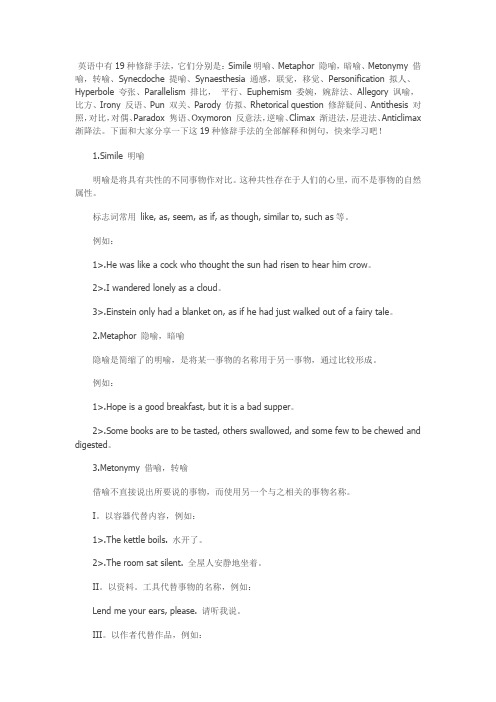
英语中有19种修辞手法,它们分别是:Simile明喻、Metaphor 隐喻,暗喻、Metonymy 借喻,转喻、Synecdoche 提喻、Synaesthesia 通感,联觉,移觉、Personification 拟人、Hyperbole 夸张、Parallelism 排比,平行、Euphemism 委婉,婉辞法、Allegory 讽喻,比方、Irony 反语、Pun 双关、Parody 仿拟、Rhetorical question 修辞疑问、Antithesis 对照,对比,对偶、Paradox 隽语、Oxymoron 反意法,逆喻、Climax 渐进法,层进法、Anticlimax 渐降法。
下面和大家分享一下这19种修辞手法的全部解释和例句,快来学习吧!1.Simile 明喻明喻是将具有共性的不同事物作对比。
这种共性存在于人们的心里,而不是事物的自然属性。
标志词常用like, as, seem, as if, as though, similar to, such as等。
例如:1>.He was like a cock who thought the sun had risen to hear him crow。
2>.I wandered lonely as a cloud。
3>.Einstein only had a blanket on, as if he had just walked out of a fairy tale。
2.Metaphor 隐喻,暗喻隐喻是简缩了的明喻,是将某一事物的名称用于另一事物,通过比较形成。
例如:1>.Hope is a good breakfast, but it is a bad supper。
2>.Some books are to be tasted, others swallowed, and some few to be chewed and digested。
英语19种修辞手法的全部解释和例句
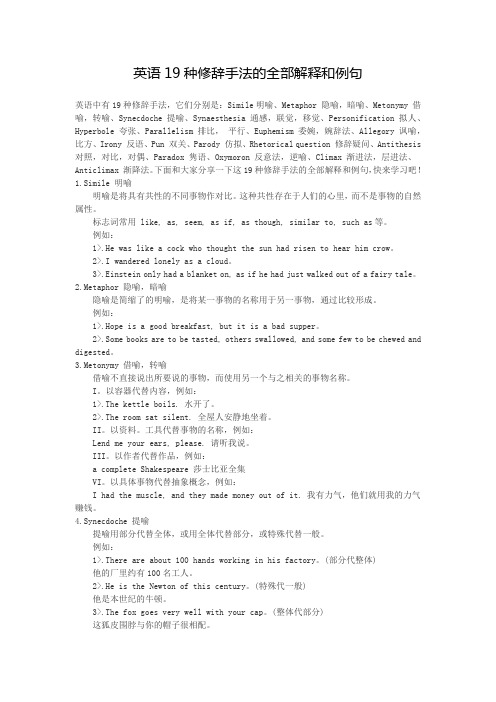
英语19种修辞手法的全部解释和例句英语中有19种修辞手法,它们分别是:Simile明喻、Metaphor 隐喻,暗喻、Metonymy 借喻,转喻、Synecdoche 提喻、Synaesthesia 通感,联觉,移觉、Personification 拟人、Hyperbole 夸张、Parallelism 排比,平行、Euphemism 委婉,婉辞法、Allegory 讽喻,比方、Irony 反语、Pun 双关、Parody 仿拟、Rhetorical question 修辞疑问、Antithesis 对照,对比,对偶、Paradox 隽语、Oxymoron 反意法,逆喻、Climax 渐进法,层进法、Anticlimax 渐降法。
下面和大家分享一下这19种修辞手法的全部解释和例句,快来学习吧!1.Simile 明喻明喻是将具有共性的不同事物作对比。
这种共性存在于人们的心里,而不是事物的自然属性。
标志词常用 like, as, seem, as if, as though, similar to, such as等。
例如:1>.He was like a cock who thought the sun had risen to hear him crow。
2>.I wandered lonely as a cloud。
3>.Einstein only had a blanket on, as if he had just walked out of a fairy tale。
2.Metaphor 隐喻,暗喻隐喻是简缩了的明喻,是将某一事物的名称用于另一事物,通过比较形成。
例如:1>.Hope is a good breakfast, but it is a bad supper。
2>.Some books are to be tasted, others swallowed, and some few to be chewed and digested。
英语修辞手法举例中英文
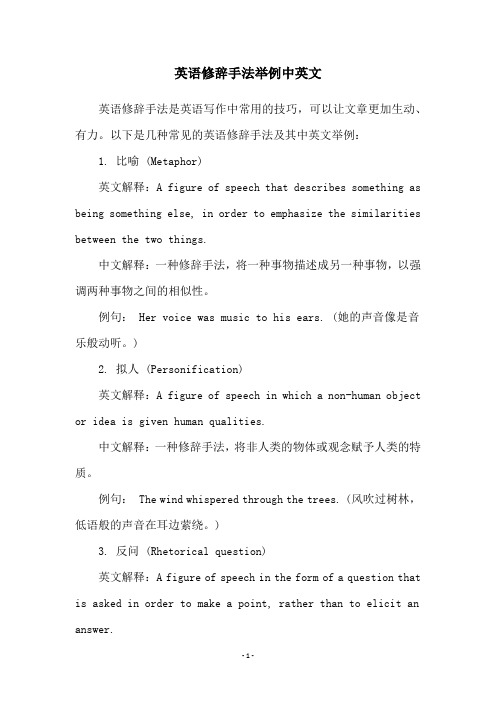
英语修辞手法举例中英文英语修辞手法是英语写作中常用的技巧,可以让文章更加生动、有力。
以下是几种常见的英语修辞手法及其中英文举例:1. 比喻 (Metaphor)英文解释:A figure of speech that describes something as being something else, in order to emphasize the similarities between the two things.中文解释:一种修辞手法,将一种事物描述成另一种事物,以强调两种事物之间的相似性。
例句: Her voice was music to his ears. (她的声音像是音乐般动听。
)2. 拟人 (Personification)英文解释:A figure of speech in which a non-human object or idea is given human qualities.中文解释:一种修辞手法,将非人类的物体或观念赋予人类的特质。
例句: The wind whispered through the trees. (风吹过树林,低语般的声音在耳边萦绕。
)3. 反问 (Rhetorical question)英文解释:A figure of speech in the form of a question that is asked in order to make a point, rather than to elicit an answer.中文解释:一种修辞手法,以问句的形式表达观点,而不是期望得到回答。
例句: Would you jump off a bridge just because your friends did? (你会因为朋友跳桥而跟随吗?)4. 排比 (Parallelism)英文解释:The use of similar grammatical structures, phrases or words to create a rhythmic and balanced effect.中文解释:一种修辞手法,使用相似的语法结构、短语或单词,以创造节奏感和平衡效果。
英语中所有19种修辞手法的全部解释和例句

英语中所有19种修辞手法的全部解释和例句:Simile明喻,Metaphor 隐喻、暗喻,Metonymy 借喻、转喻,Synecdoche 提喻,Synaesthesia 通感、联觉、移觉,Personification 拟人,Hyperbole 夸张,Parallelism 排比、平行,Euphemism 委婉、婉辞法,Allegory 讽喻、比方,Irony 反语,Pun 双关,Parody 仿拟,Rhetorical question 修辞疑问,Antithesis 对照、对比、对偶,Paradox 隽语,Oxymoron 反意法、逆喻,Climax 渐进法、层进法,Anticlimax 渐降法快来学习吧!1.Simile 明喻明喻是将具有共性的不同事物作对比.这种共性存在于人们的心里,而不是事物的自然属性. 标志词常用 like, as, seem, as if, as though, similar to, such as等.例如:1>.He was like a cock who thought the sun had risen to hear him crow.2>.I wandered lonely as a cloud.3>.Einstein only had a blanket on, as if he had just walked out of a fairy tale.2.Metaphor 隐喻,暗喻隐喻是简缩了的明喻,是将某一事物的名称用于另一事物,通过比较形成.例如:1>.Hope is a good breakfast, but it is a bad supper.2>.Some books are to be tasted, others swallowed, and some few to be chewed and dig ested.3.Metonymy 借喻,转喻借喻不直接说出所要说的事物,而使用另一个与之相关的事物名称.I.以容器代替内容,例如:1>.The kettle boils. 水开了.2>.The room sat silent. 全屋人安静地坐着.II.以资料.工具代替事物的名称,例如:Lend me your ears, please. 请听我说.III.以作者代替作品,例如:a complete Shakespeare 莎士比亚全集VI.以具体事物代替抽象概念,例如:I had the muscle, and they made money out of it. 我有力气,他们就用我的力气赚钱.4.Synecdoche 提喻提喻用部分代替全体,或用全体代替部分,或特殊代替一般.例如:1>.There are about 100 hands working in his factory.(部分代整体)他的厂里约有100名工人.2>.He is the Newton of this century.(特殊代一般)他是本世纪的牛顿.3>.The fox goes very well with your cap.(整体代部分)这狐皮围脖与你的帽子很相配.5.Synaesthesia 通感,联觉,移觉这种修辞法是以视.听.触.嗅.味等感觉直接描写事物.通感就是把不同感官的感觉沟通起来,借联想引起感觉转移,“以感觉写感觉”。
英语中所有19种修辞手法的全部解释和例句
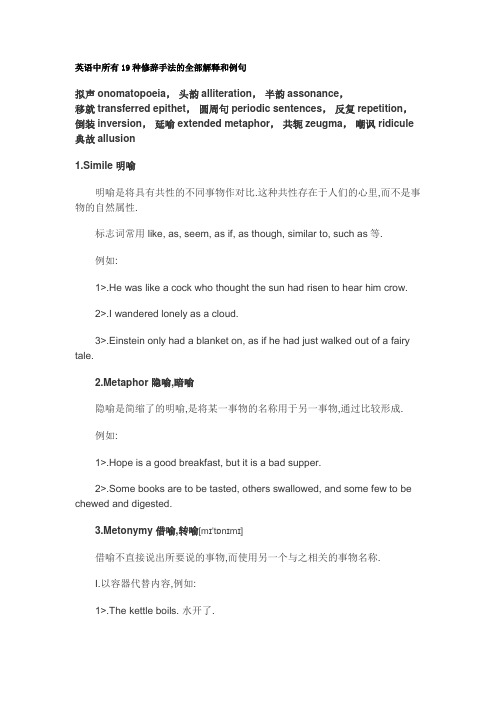
英语中所有19种修辞手法的全部解释和例句拟声onomatopoeia,头韵alliteration,半韵assonance,移就transferred epithet,圆周句periodic sentences,反复repetition,倒装inversion,延喻 extended metaphor,共轭zeugma,嘲讽 ridicule 典故allusion1.Simile 明喻明喻是将具有共性的不同事物作对比.这种共性存在于人们的心里,而不是事物的自然属性.标志词常用 like, as, seem, as if, as though, similar to, such as等.例如:1>.He was like a cock who thought the sun had risen to hear him crow.2>.I wandered lonely as a cloud.3>.Einstein only had a blanket on, as if he had just walked out of a fairy tale.2.Metaphor 隐喻,暗喻隐喻是简缩了的明喻,是将某一事物的名称用于另一事物,通过比较形成.例如:1>.Hope is a good breakfast, but it is a bad supper.2>.Some books are to be tasted, others swallowed, and some few to be chewed and digested.3.Metonymy 借喻,转喻[mɪ'tɒnɪmɪ]借喻不直接说出所要说的事物,而使用另一个与之相关的事物名称.I.以容器代替内容,例如:1>.The kettle boils. 水开了.2>.The room sat silent. 全屋人安静地坐着.II.以资料.工具代替事物的名称,例如:Lend me your ears, please. 请听我说.III.以作者代替作品,例如:a complete Shakespeare 莎士比亚全集VI.以具体事物代替抽象概念,例如:I had the muscle, and they made money out of it. 我有力气,他们就用我的力气赚钱.4.Synecdoche 提喻[sɪ'nekdəkɪ]提喻用部分代替全体,或用全体代替部分,或特殊代替一般.例如:1>.There are about 100 hands working in his factory.(部分代整体)他的厂里约有100名工人.2>.He is the Newton of this century.(特殊代一般)他是本世纪的牛顿.3>.The fox goes very well with your cap.(整体代部分)这狐皮围脖与你的帽子很相配.5.Synaesthesia 通感,联觉,移觉[,sɪnɪs'θiːzɪə]这种修辞法是以视.听.触.嗅.味等感觉直接描写事物.通感就是把不同感官的感觉沟通起来,借联想引起感觉转移,“以感觉写感觉”。
英语修辞手法英语定义
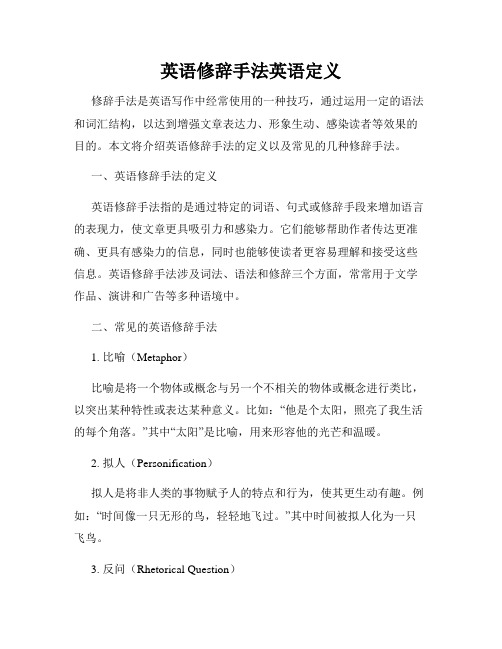
英语修辞手法英语定义修辞手法是英语写作中经常使用的一种技巧,通过运用一定的语法和词汇结构,以达到增强文章表达力、形象生动、感染读者等效果的目的。
本文将介绍英语修辞手法的定义以及常见的几种修辞手法。
一、英语修辞手法的定义英语修辞手法指的是通过特定的词语、句式或修辞手段来增加语言的表现力,使文章更具吸引力和感染力。
它们能够帮助作者传达更准确、更具有感染力的信息,同时也能够使读者更容易理解和接受这些信息。
英语修辞手法涉及词法、语法和修辞三个方面,常常用于文学作品、演讲和广告等多种语境中。
二、常见的英语修辞手法1. 比喻(Metaphor)比喻是将一个物体或概念与另一个不相关的物体或概念进行类比,以突出某种特性或表达某种意义。
比如:“他是个太阳,照亮了我生活的每个角落。
”其中“太阳”是比喻,用来形容他的光芒和温暖。
2. 拟人(Personification)拟人是将非人类的事物赋予人的特点和行为,使其更生动有趣。
例如:“时间像一只无形的鸟,轻轻地飞过。
”其中时间被拟人化为一只飞鸟。
3. 反问(Rhetorical Question)反问是提出一个问题,但并不期望得到回答,而是用来强调观点或引起读者的思考。
例如:“你难道不希望自己过上幸福快乐的生活吗?”这个反问句用来表达作者的期待和呼吁。
4. 排比(Parallelism)排比是将多个相同或相似的句式结构或词语进行并列排列,以增加语言的节奏感和修辞效果。
比如:“春风送暖,夏日炎炎,秋叶飘落,冬雪皑皑。
”这个句子中的排比使用了相似的句式和词语,使得句子更流畅、有韵律感。
5. 夸张(Hyperbole)夸张是为了强调某个事物或情感,故意夸大其表达,以产生强烈的效果。
例如:“我饿得可以吞下一头大象!”这句话用夸张的方式表达了饥饿的感受。
6. 反复(Repetition)反复是指有意词语或句子的重复出现,以加强表达力和引起读者的共鸣。
例如:“Never give up, never give in.”这种反复使用相同词语的表达方式,可以使观点更加坚定和有力。
英语中所有种修辞手法的全部解释和例句
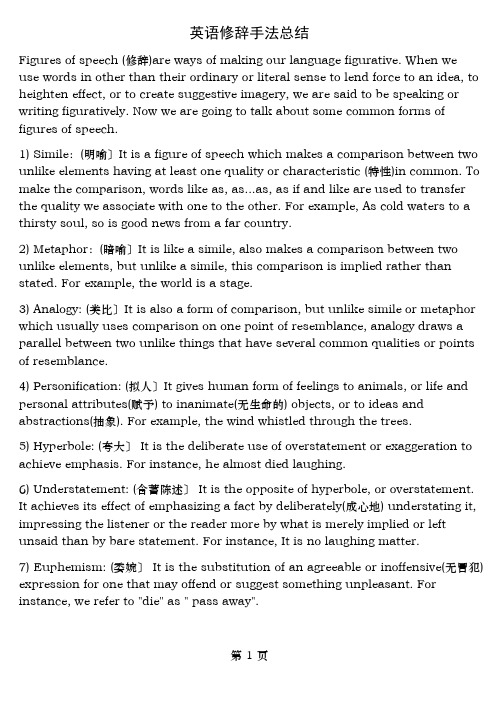
英语修辞手法总结Figures of speech (修辞)are ways of making our language figurative. When we use words in other than their ordinary or literal sense to lend force to an idea, to heighten effect, or to create suggestive imagery, we are said to be speaking or writing figuratively. Now we are going to talk about some common forms of figures of speech.1) Simile:(明喻〕It is a figure of speech which makes a comparison between two unlike elements having at least one quality or characteristic (特性)in common. To make the comparison, words like as, as...as, as if and like are used to transfer the quality we associate with one to the other. For example, As cold waters to a thirsty soul, so is good news from a far country.2) Metaphor:(暗喻〕It is like a simile, also makes a comparison between two unlike elements, but unlike a simile, this comparison is implied rather than stated. For example, the world is a stage.3) Analogy: (类比〕It is also a form of comparison, but unlike simile or metaphor which usually uses comparison on one point of resemblance, analogy draws a parallel between two unlike things that have several common qualities or points of resemblance.4) Personification: (拟人〕It gives human form of feelings to animals, or life and personal attributes(赋予) to inanimate(无生命的) objects, or to ideas and abstractions(抽象). For example, the wind whistled through the trees.5) Hyperbole: (夸大〕 It is the deliberate use of overstatement or exaggeration to achieve emphasis. For instance, he almost died laughing.6) Understatement: (含蓄陈述〕 It is the opposite of hyperbole, or overstatement. It achieves its effect of emphasizing a fact by deliberately(成心地) understating it, impressing the listener or the reader more by what is merely implied or left unsaid than by bare statement. For instance, It is no laughing matter.7) Euphemism: (委婉〕 It is the substitution of an agreeable or inoffensive(无冒犯) expression for one that may offend or suggest something unpleasant. For instance, we refer to "die" as " pass away".8) Metonymy (转喻〕It is a figure of speech that has to do with the substitution of the mane of one thing for that of another. For instance, the pen (words) is mightier than the sword (forces).9) Synecdoche (提喻〕 It is involves the substitution of the part for the whole, or thewhole for the part. For instance, they say there's bread and work for all. She was dressed in silks.10) Antonomasia (换喻〕It has also to do with substitution. It is not often mentioned now, though it is still in frequent use. For example, Solomon for a wise man. Daniel for a wise and fair judge. Judas for a traitor.11) Pun: (双关语〕 It is a play on words, or rather a play on the form and meaning of words. For instance, a cannon-ball took off his legs, so he laid down his arms. (Here "arms" has two meanings: a person's body; weapons carried by a soldier.)12) Syllepsis: (一语双叙〕 It has two connotations.In the first case, it is a figure by which a word, or a particular form or inflection of a word, refers to two or more words in the same sentence, while properly applying to or agreeing with only on of them in grammar or syntax(句法). For example, He addressed you and me, and desired us to follow him. (Here us is used to refer to you and me.)In the second case, it a word may refer to two or more words in the same sentence. For example, while he was fighting , and losing limb and mind, and dying, others stayed behind to pursue education and career. (Here to losingone's limbs in literal; to lose one's mind is figurative, and means to go mad.)13) Zeugma: (轭式搭配〕 It is a single word which is made to modify or to govern two or more words in the same sentence, wither properly applying in sense to only one of them, or applying to them in different senses. For example, The sun shall not burn you by day, nor the moon by night. (Here noon is not strong enough to burn)14) Irony: (反语〕 It is a figure of speech that achieves emphasis by saying the opposite of what is meant, the intended meaning of the words being the oppositeof their usual sense. For instance, we are lucky, what you said makes me feel real good.15) Innuendo: (暗讽〕 It is a mild form of irony, hinting in a rather roundabout (曲折)way at something disparaging(不一致) or uncomplimentary(不赞美) to the person or subject mentioned. For example, the weatherman said it would be worm. He must take his readings in a bathroom.16) Sarcasm: (挖苦〕 It Sarcasm is a strong form of irony. It attacks in a taunting and bitter manner, and its aim is to disparage, ridicule and wound the feelings of the subject attacked. For example, laws are like cobwebs, which may catch small flies, but let wasps break through.17) Paradox: (似非而是的隽语〕 It is a figure of speech consisting of a statementor proposition which on the face of it seems self-contradictory, absurd or contrary to established fact or practice, but which on further thinking and study may prove to be true, well-founded, and even to contain a succinct point. For example more haste, less speed.18) Oxymoron: (矛盾修饰〕 It is a compressed paradox, formed by the conjoining(结合) of two contrasting, contradictory or incongruous(不协调) terms as in bitter-sweet memories, orderly chaos(混乱) and proud humility(侮辱).19) Antithesis: (对照〕 It is the deliberate arrangement of contrasting words or ideas in balanced structural forms to achieve emphasis. For example, speech is silver; silence is golden.20) Epigram: (警句〕 It states a simple truth pithily(有利地) and pungently(强烈地). It is usually terse and arouses interest and surprise by its deep insight into certain aspects of human behavior or feeling. For instance, Few, save the poor, feel for the poor.21) Climax: (渐进〕 It is derived from the Greek word for "ladder" and implies the progression of thought at a uniform or almost uniform rate of significance or intensity, like the steps of a ladder ascending evenly. For example, I came, I saw,I conquered.22) Anti-climax or bathos: (突降〕It is the opposite of Climax. It involves stating one's thoughts in a descending order of significance or intensity, from strong toweak, from weighty to light or frivolous. For instance, But thousands die, without or this or that, die, and endow(赋予) a college, or a cat.23) Apostrophe: (顿呼〕 In this figure of speech, a thing, place, idea or person (dead or absent) is addressed as if present, listening and understanding what is being said. For instance, England! awake! awake! awake!24) Transferred Epithet: (转类形容词〕 It is a figure of speech where an epithet (an adjective or descriptive phrase) is transferred from the noun it should rightly modify(修饰) to another to which it does not really apply or belong. For instance,I spent sleepless nights on my project.25) Alliteration: (头韵〕 It has to do with the sound rather than the sense of words for effect. It is a device that repeats the same sound at frequentintervals(间隔) and since the sound repeated is usually the initial consonant sound, it is also called "front rhyme". For instance, the fair breeze blew, the white foam flew, the furrow followed free.26) Onomatopoeia: (拟声〕 It is a device that uses words which imitate the sounds made by an object (animate or inanimate), or which are associated with or suggestive(提示的) of some action or movementExplanation version1一、什么是修辞格修辞格(figures of speech)是提高语言表达效果的语言艺术。
英语30种修辞手法
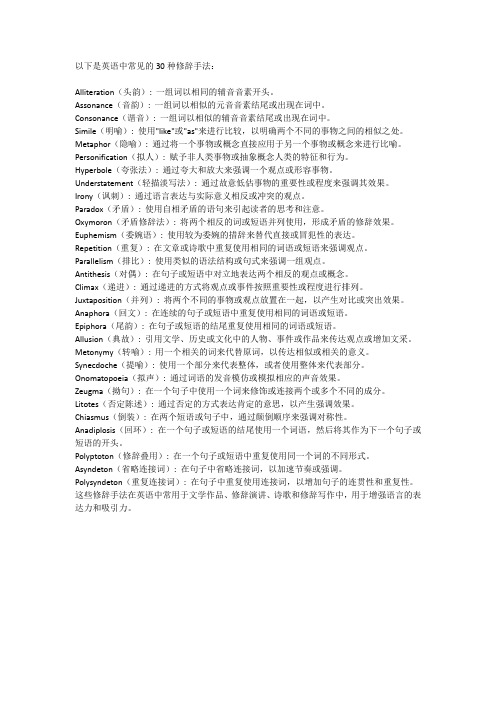
以下是英语中常见的30种修辞手法:Alliteration(头韵): 一组词以相同的辅音音素开头。
Assonance(音韵): 一组词以相似的元音音素结尾或出现在词中。
Consonance(谐音): 一组词以相似的辅音音素结尾或出现在词中。
Simile(明喻): 使用"like"或"as"来进行比较,以明确两个不同的事物之间的相似之处。
Metaphor(隐喻): 通过将一个事物或概念直接应用于另一个事物或概念来进行比喻。
Personification(拟人): 赋予非人类事物或抽象概念人类的特征和行为。
Hyperbole(夸张法): 通过夸大和放大来强调一个观点或形容事物。
Understatement(轻描淡写法): 通过故意低估事物的重要性或程度来强调其效果。
Irony(讽刺): 通过语言表达与实际意义相反或冲突的观点。
Paradox(矛盾): 使用自相矛盾的语句来引起读者的思考和注意。
Oxymoron(矛盾修辞法): 将两个相反的词或短语并列使用,形成矛盾的修辞效果。
Euphemism(委婉语): 使用较为委婉的措辞来替代直接或冒犯性的表达。
Repetition(重复): 在文章或诗歌中重复使用相同的词语或短语来强调观点。
Parallelism(排比): 使用类似的语法结构或句式来强调一组观点。
Antithesis(对偶): 在句子或短语中对立地表达两个相反的观点或概念。
Climax(递进): 通过递进的方式将观点或事件按照重要性或程度进行排列。
Juxtaposition(并列): 将两个不同的事物或观点放置在一起,以产生对比或突出效果。
Anaphora(回文): 在连续的句子或短语中重复使用相同的词语或短语。
Epiphora(尾韵): 在句子或短语的结尾重复使用相同的词语或短语。
Allusion(典故): 引用文学、历史或文化中的人物、事件或作品来传达观点或增加文采。
浅谈英语中常用的修辞手法
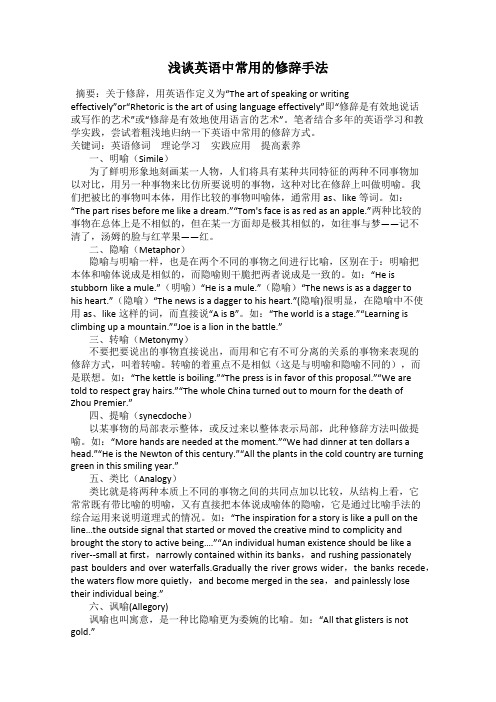
浅谈英语中常用的修辞手法摘要:关于修辞,用英语作定义为“The art of speaking or writingeffectively”or“Rhetoric is the art of using language effectively”即“修辞是有效地说话或写作的艺术”或“修辞是有效地使用语言的艺术”。
笔者结合多年的英语学习和教学实践,尝试着粗浅地归纳一下英语中常用的修辞方式。
关键词:英语修词理论学习实践应用提高素养一、明喻(Simile)为了鲜明形象地刻画某一人物,人们将具有某种共同特征的两种不同事物加以对比,用另一种事物来比仿所要说明的事物,这种对比在修辞上叫做明喻。
我们把被比的事物叫本体,用作比较的事物叫喻体,通常用as、like等词。
如:“The part rises before me like a dream.”“Tom's face is as red as an apple.”两种比较的事物在总体上是不相似的,但在某一方面却是极其相似的,如往事与梦——记不清了,汤姆的脸与红苹果——红。
二、隐喻(Metaphor)隐喻与明喻一样,也是在两个不同的事物之间进行比喻,区别在于:明喻把本体和喻体说成是相似的,而隐喻则干脆把两者说成是一致的。
如:“He is stubborn like a mule.”(明喻)“He is a mule.”(隐喻)“The news is as a dagger tohis heart.”(隐喻)“The news is a dagger to his heart.”(隐喻)很明显,在隐喻中不使用as、like这样的词,而直接说“A is B”。
如:“The world is a stage.”“Learning is climbing up a mountain.”“Joe is a lion in the battle.”三、转喻(Metonymy)不要把要说出的事物直接说出,而用和它有不可分离的关系的事物来表现的修辞方式,叫着转喻。
英语最全修辞手法
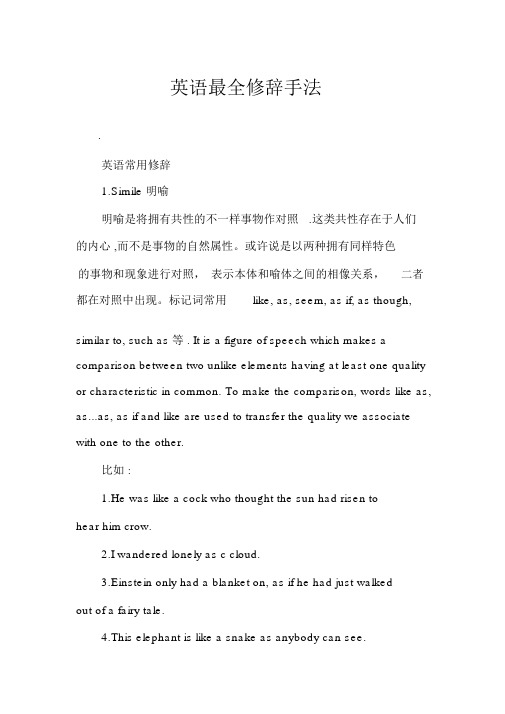
英语最全修辞手法.英语常用修辞1.Simile 明喻明喻是将拥有共性的不一样事物作对照.这类共性存在于人们的内心 ,而不是事物的自然属性。
或许说是以两种拥有同样特色的事物和现象进行对照,表示本体和喻体之间的相像关系,二者都在对照中出现。
标记词常用like, as, seem, as if, as though, similar to, such as 等 . It is a figure of speech which makes a comparison between two unlike elements having at least one quality or characteristic in common. To make the comparison, words like as, as...as, as if and like are used to transfer the quality we associate with one to the other.比如 :1.He was like a cock who thought the sun had risen tohear him crow.2.I wandered lonely as c cloud.3.Einstein only had a blanket on, as if he had just walkedout of a fairy tale.4.This elephant is like a snake as anybody can see.这头象和任何人见到的同样像一条蛇。
5.He looked as if he had just stepped out of my book of fairytales andhad passed me like a spirit.他看上去仿佛刚从我的童话故事书中走出来,像幽灵同样从我身边走过去。
英语修辞手法分析大全+英语文章分析赏析
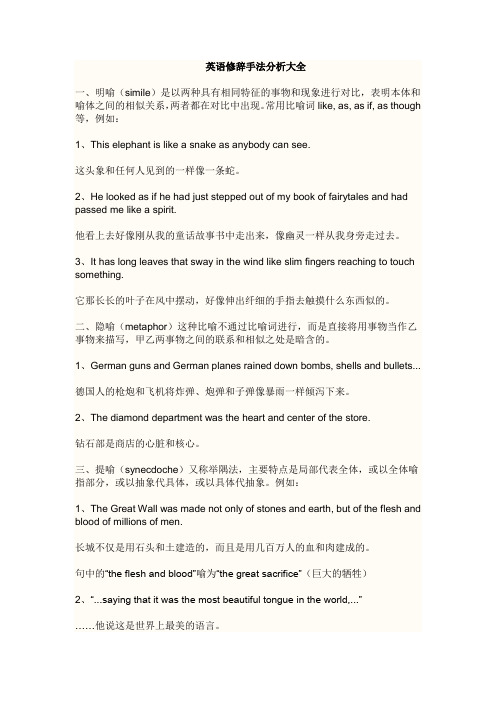
英语修辞手法分析大全一、明喻(simile)是以两种具有相同特征的事物和现象进行对比,表明本体和喻体之间的相似关系,两者都在对比中出现。
常用比喻词like, as, as if, as though 等,例如:1、This elephant is like a snake as anybody can see.这头象和任何人见到的一样像一条蛇。
2、He looked as if he had just stepped out of my book of fairytales and had passed me like a spirit.他看上去好像刚从我的童话故事书中走出来,像幽灵一样从我身旁走过去。
3、It has long leaves that sway in the wind like slim fingers reaching to touch something.它那长长的叶子在风中摆动,好像伸出纤细的手指去触摸什么东西似的。
二、隐喻(metaphor)这种比喻不通过比喻词进行,而是直接将用事物当作乙事物来描写,甲乙两事物之间的联系和相似之处是暗含的。
1、German guns and German planes rained down bombs, shells and bullets...德国人的枪炮和飞机将炸弹、炮弹和子弹像暴雨一样倾泻下来。
2、The diamond department was the heart and center of the store.钻石部是商店的心脏和核心。
三、提喻(synecdoche)又称举隅法,主要特点是局部代表全体,或以全体喻指部分,或以抽象代具体,或以具体代抽象。
例如:1、The Great Wall was made not only of stones and earth, but of the flesh and blood of millions of men.长城不仅是用石头和土建造的,而且是用几百万人的血和肉建成的。
英语修辞的名词解释
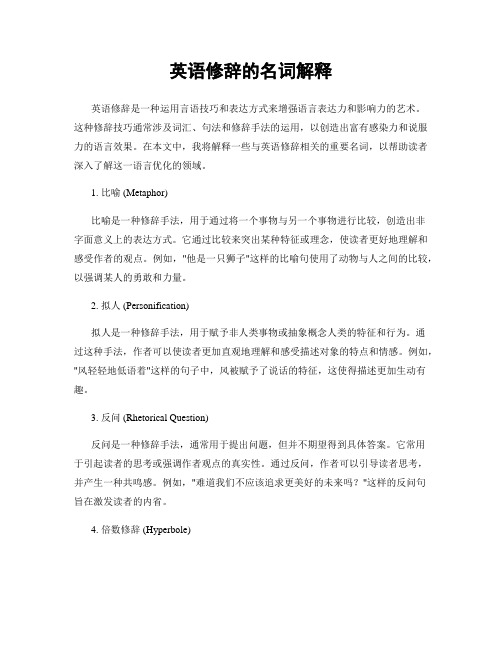
英语修辞的名词解释英语修辞是一种运用言语技巧和表达方式来增强语言表达力和影响力的艺术。
这种修辞技巧通常涉及词汇、句法和修辞手法的运用,以创造出富有感染力和说服力的语言效果。
在本文中,我将解释一些与英语修辞相关的重要名词,以帮助读者深入了解这一语言优化的领域。
1. 比喻 (Metaphor)比喻是一种修辞手法,用于通过将一个事物与另一个事物进行比较,创造出非字面意义上的表达方式。
它通过比较来突出某种特征或理念,使读者更好地理解和感受作者的观点。
例如,"他是一只狮子"这样的比喻句使用了动物与人之间的比较,以强调某人的勇敢和力量。
2. 拟人 (Personification)拟人是一种修辞手法,用于赋予非人类事物或抽象概念人类的特征和行为。
通过这种手法,作者可以使读者更加直观地理解和感受描述对象的特点和情感。
例如,"风轻轻地低语着"这样的句子中,风被赋予了说话的特征,这使得描述更加生动有趣。
3. 反问 (Rhetorical Question)反问是一种修辞手法,通常用于提出问题,但并不期望得到具体答案。
它常用于引起读者的思考或强调作者观点的真实性。
通过反问,作者可以引导读者思考,并产生一种共鸣感。
例如,"难道我们不应该追求更美好的未来吗?"这样的反问句旨在激发读者的内省。
4. 倍数修辞 (Hyperbole)倍数修辞是一种夸张或夸大的修辞手法,常用于强调某种感觉、情感或事物的程度。
通过夸张的修辞手法,作者可以让读者对描述的对象产生更强烈的印象。
例如,"我等了一个世纪"这样的表达方式明显夸大了等待的时间长短。
5. 平行句 (Parallelism)平行句是一种修辞手法,通过对语法结构或单词的重复使用来创造出韵律、力量和对称感。
通过平行句,作者可以增强语句的节奏感,并使读者更加专注于所陈述的内容。
例如,"今天追求繁荣、明天追求幸福、永远追求我们的梦想"这样的平行结构增强了句子的说服力。
- 1、下载文档前请自行甄别文档内容的完整性,平台不提供额外的编辑、内容补充、找答案等附加服务。
- 2、"仅部分预览"的文档,不可在线预览部分如存在完整性等问题,可反馈申请退款(可完整预览的文档不适用该条件!)。
- 3、如文档侵犯您的权益,请联系客服反馈,我们会尽快为您处理(人工客服工作时间:9:00-18:30)。
英语中的45种修辞(1)alliteration(押头韵):一组单词的第一个辅音相同,比如例句中四个以l开头的单词。
▲ Let us go forth to lead the land we love.(2)anacoluthon(错格):句子从一种结构变成另外一种结构,比如例句由肯定结构变成疑问结构。
▲ As a regular reader of your papers -- Why does it give so little space to science?(3)anadiplosis(联珠):将一个或一组单词重复多遍,比如例句中的servants。
▲ Men in great place are thrice servants: servants of state, servants of fame, and servants of business.(4)anaphora(首语重复):将一个句子的开头单词或短语,在随后的句子中重复多遍,比如例句中的we shall fight。
▲ We shall fight on the seas and oceans, we shall fight on the beaches, we shall fight on the landing grounds, we shall fight in the fields and in the streets, we shall fight in the hills.(5)anastrophe(词序倒装): 改变正常词序,比如例句中最后一部分,正常词序是yet a breeze never blew up 。
▲ The helmsman steered, the ship moved on, yet never a breeze up blew.(6)antistrophe(逆反复):在每个句子的结尾,重复相同的单词或短语,比如例句中的without warning。
▲ In 1931, Japan invaded Manchuria, without warning. In 1935, Italy inv aded Ethiopia, without warning. In 1938, Hitler occupied Austria, without warning.(7)antithesis(对偶):两个或多个句子,结构相同,但含义相反,或者含义形成对比,比如例句中的is no vice与is no virtue。
▲ Extremism in the defense of liberty is no vice, moderation in the pursuit of justice is no virtue.(8)aporia(假装疑问):假装表示疑问,做出对某件事情好象不太肯定的样子,比如例句的最后部分。
▲ Then the steward said within himself, ’What shall I do?’(9)aposiopesis(中断):突然中断一个句子,以表示恐惧、兴奋等感情,比如例句在I saw后面中断。
▲ The first thing I saw -- But I dare not describe the dreadful sight.(10)apostrophe(顿呼):在叙述过程中,突然对不在场的第三人(或拟人化的抽象事物)的称呼,比如例句中的O you gods。
▲ Judge, O you gods, how dearly Caesar loved him.(11)archaism(拟古):使用古体单词,或者已废弃单词,比如例句中的sate(sit的古体过去式和过去分词)。
▲ Pipit sate upright in her chair, some distance from where I was sitting.(12)assonance(协音):重复某个发音相同或相似的音节,比如例句中的Thy/thy和-dom/done。
▲ Thy kingdom come, thy will be done.(13)asyndeton(连接词省略):省略单词、短语或从句之间的连接词,比如例句省略了两个连接词and。
▲ But, in a larger sense, we cannot dedicate, we cannot consecrate, we cannot hallow this ground.(14)brachylogy(省略):省略一个不太重要、读者通常可以猜出的单词或短语,比如例句省略了out后面的of。
▲ He looked out the window.(15)cacophony(杂音):使用一组发音不和谐的单词,以便让人听着不舒服,比如例句中的一组单词。
▲ We want no parlay with you and your grisly gang who work your wicked will.(16)catachresis(生硬比喻):用不准确的单词进行不准确的比喻,比如例句中的thirsty ear。
▲ I listen vainly, but with thirsty ear.(17)chiasmus(交错配列):两个对应部分没有按照a-b-a-b顺序排列,而是按照a-b-b-a顺序排列,比如例句中的(often) (in my thoughts) and (in my prayers) (always)。
▲ Those gallant men will remain often in my thoughts and in my pray ers always.(18)climax(渐强):重新排列单词、短语或从句,以便让整个句子具有语气逐渐增强的效果,比如例句最后部分and not to yield是整句的高潮。
▲ One equal temper of heroic hearts, made weak by time and fate, but strong in will, to strive, to seek, to find, and not to yield.(19)euphemism(委婉):用礼貌、非冒犯性的表达,代替不礼貌、冒犯性的表达,比如例句中的passed away和went to be with the Lord。
▲ Charles Shively, 94, passed away at home and went to be with the Lord on April 22, 2004, from natural causes.(20)hendiadys(重言):用and连接两个名词,以代替一个形容词和一个名词,比如例句中的voice and supplication,代替supplicatory voice。
▲ I love the Lord, because he has heard my voice and supplication.(21)hypallage(换置):交换两个单词的位置,交换之后的句子符合语法,但不一定符合逻辑,比如左边的例句变成右边的例句。
▲ Apply water to the wound. -- Apply the wound to water.(22)hyperbaton(倒装):颠倒句子各个部分,通常是颠倒主语和谓语,比如左边的例句可以变成右边的例句。
▲ He is happy. -- Happy is he.(23)hyperbole(夸张):通过夸张达到某种修辞效果,比如例句中的An hundred years.▲ An hundred years should got to praise thine eyes and on thine forehead gaze, two hundred to adore each breast, but thirty thousand to the rest.(24)hysteron proteron(逆序):故意颠倒事件发生的自然顺序,也就是后发生的先说,先发生的后说,比如左边的例句变成右边的例句。
▲ I fall, I faint, I die. -- I die, I faint, I fall.(25)irony(反语):字面意思与说话人实际想要表达的意思不一致,通常用来讽刺,比如例句中的an honourable man。
▲ Yet Brutus says he was ambitious, and Brutus is an honourable man.(26)litotes(曲意):利用否定的形式,表达肯定的意思,比如例句中的not healthy相当于dangerous。
▲ War is not healthy for children and other living things.(27)metaphor(隐喻):利用某些单词进行含蓄的比喻,此时这些单词已经不再是字面上的意思了,比如例句中的an iron curtain。
▲ From Stettin in the Baltic to Trieste in the Adriatic, an iron curtain has descended across the continent.(28)metonymy(换喻)用一个单词代替另外一个在概念上有关联的单词,比如例句中的sword,用来代替war。
▲ The pen is mightier than the sword.(29)onomatopoeia(拟声):模拟自然界的各种声音,比如例句中的ticktacking。
▲ I hear the clock ticktacking, and time goes by.(30)oxymoron(矛盾修饰):使用两个或多个自相矛盾的单词,比如例句中的cruel和kind。
▲ I must be cruel only to be kind.(31)paradox(佯谬):似是而非、或者似非而是的表达,比如例句中关于youth的看法。
▲ What a pity that youth must be wasted on the young.(32)paraleipsis(假省):故意省略某个部分之后,修辞效果反而更强,比如例句中possessions后面的省略。
▲ That part of our history detailing the military achievements which gave us our several possessions ... is a theme too familiar to my listeners for me to dilate on, and I shall therefore pass it by.(33)paraprosdokian(没有汉语译文):一个句子的结尾令人感到吃惊,或者令人感到意外,比如例句中的the wall behind me。
